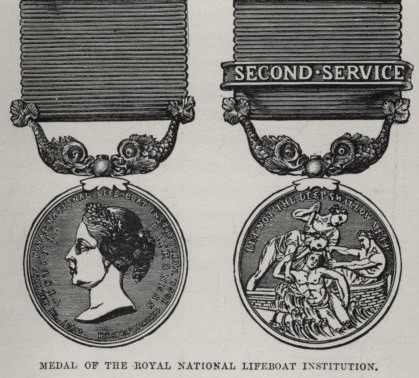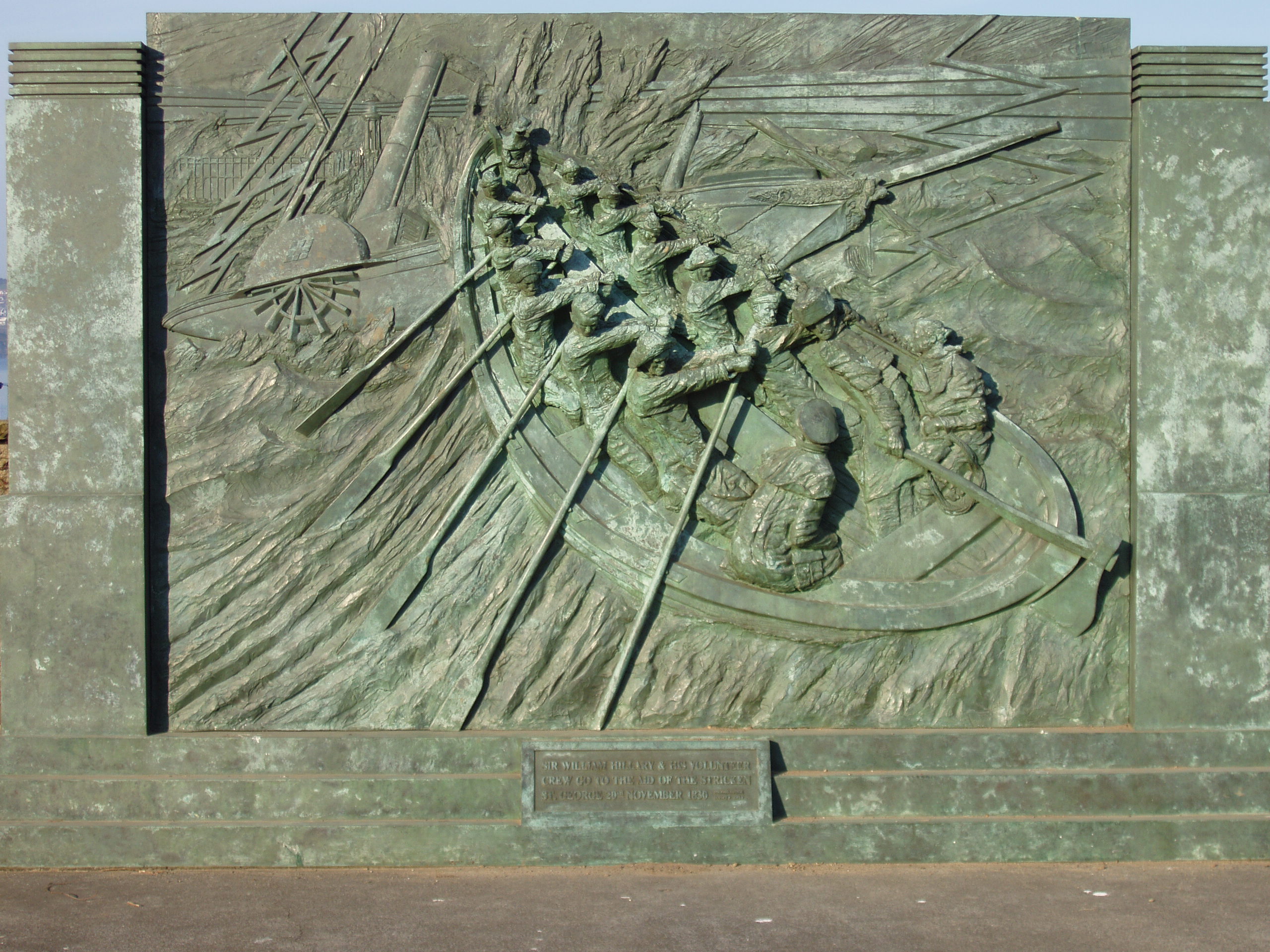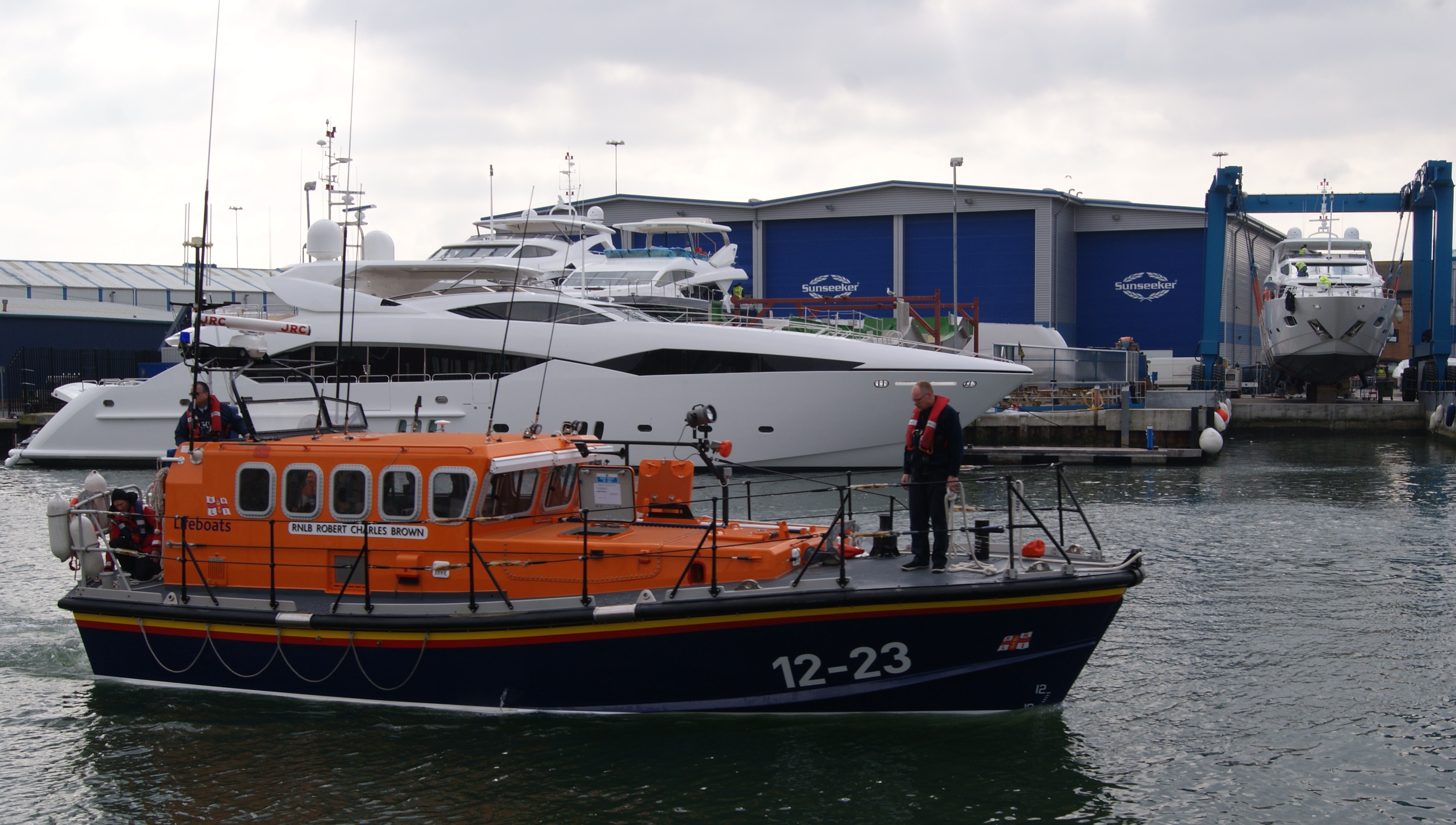|
Yarmouth Lifeboat Station
Yarmouth Lifeboat station (not to be confused with ) is an RNLI station located in the town of Yarmouth on the Isle of Wight in the United Kingdom.OS Explorer Map OL29 – Isle of Wight, Folded Map. Publisher:Ordnance Survey; B2 edition (17 Mar 2008). The station has been based in Yarmouth's harbour since 1924. Previously the station had been in Totland Bay, west of Yarmouth, until it was decided that the station need a motor lifeboat. The current Severn-class lifeboat is moored afloat and shore facilities are on the quayside in Yarmouth. The station covers the western Solent with its all-weather lifeboat '' Eric and Susan Hiscock (Wanderer) (ON-1249)'' which has been on service at Yarmouth since 2001. Eric and Susan Hiscock (Wanderer) ''Eric and Susan Hiscock (Wanderer)'' has a top speed of and a range of . She is operated by a crew of six and is fitted with the latest in navigation, location and communication equipment including electronic chart plotter, VHF radio with dir ... [...More Info...] [...Related Items...] OR: [Wikipedia] [Google] [Baidu] |
RNLI
The Royal National Lifeboat Institution (RNLI) is the largest charity that saves lives at sea around the coasts of the United Kingdom, the Republic of Ireland, the Channel Islands, and the Isle of Man, as well as on some inland waterways. It is one of several lifeboat services operating in the same area. Founded in 1824 as the National Institution for the Preservation of Life from Shipwreck, soon afterwards becoming the Royal National Institution for the Preservation of Life from Shipwreck, under the patronage of King George IV. On 5 October 1854, the institution’s name was changed to its current name (RNLI), and in 1860 was granted a royal charter. The RNLI is a charity in the UK and in the Republic of Ireland and has enjoyed royal patronage since its foundation, the most recent being Queen Elizabeth II until her death on 8 September 2022. The RNLI is principally funded by legacies (65%) and donations (28%), with the remainder from merchandising and investment. Most of th ... [...More Info...] [...Related Items...] OR: [Wikipedia] [Google] [Baidu] |
English Channel
The English Channel, "The Sleeve"; nrf, la Maunche, "The Sleeve" (Cotentinais) or ( Jèrriais), (Guernésiais), "The Channel"; br, Mor Breizh, "Sea of Brittany"; cy, Môr Udd, "Lord's Sea"; kw, Mor Bretannek, "British Sea"; nl, Het Kanaal, "The Channel"; german: Ärmelkanal, "Sleeve Channel" ( French: ''la Manche;'' also called the British Channel or simply the Channel) is an arm of the Atlantic Ocean that separates Southern England from northern France. It links to the southern part of the North Sea by the Strait of Dover at its northeastern end. It is the busiest shipping area in the world. It is about long and varies in width from at its widest to at its narrowest in the Strait of Dover."English Channel". ''The Columbia Encyclopedia'', 2004. It is the smallest of the shallow seas around the continental shelf of Europe, covering an area of some . The Channel was a key factor in Britain becoming a naval superpower and has been utilised by Britain as a natural def ... [...More Info...] [...Related Items...] OR: [Wikipedia] [Google] [Baidu] |
Cowes Lifeboat Station
Cowes () is an English seaport town and civil parish on the Isle of Wight. Cowes is located on the west bank of the estuary of the River Medina, facing the smaller town of East Cowes on the east bank. The two towns are linked by the Cowes Floating Bridge, a chain ferry. As of 2020 it had an estimated population of 14,724. Charles Godfrey Leland's 19th-century verses describe the towns poetically as "The two great Cowes that in loud thunder roar/This on the eastern, that the western shore". Cowes has been seen as a home for international yacht racing since the founding of the Royal Yacht Squadron in 1815. It gives its name to the world's oldest regular regatta, Cowes Week, which occurs annually in the first week of August. Later, powerboat races are held. Much of the town's architecture is still heavily influenced by the style of ornate building that Prince Albert popularised. History Name The name ''Westcowe'' was attested in 1413 as the name of one of two sandbanks, on ... [...More Info...] [...Related Items...] OR: [Wikipedia] [Google] [Baidu] |
Calshot Lifeboat Station
Calshot Lifeboat Station is located on Calshot Spit near the village of Calshot, Hampshire,OS Explorer Map, New Forest, Author: Ordnance Survey. Publisher: Ordnance Survey B4 edition (2013). and is on the southern bank of the open end of Southampton Water, on the south coast of England. The station is owned and operated by the Royal National Lifeboat Institution (RNLI) and currently operates two inshore lifeboats. They are an called and a called . History Until its closure in 1961, Calshot Spit had been the site of Royal Air Force station RAF Calshot, which was the primary seaplane/flying boat development and training unit in the United Kingdom. After the departure of the RAF, Hampshire County Council opened an educational activities centre on the site, which was The centre was constantly being asked by HM Coastguard to use its boats to go out and rescue people in trouble off shore. The administrators of the centre decided that they would contact the RNLI with a view to ... [...More Info...] [...Related Items...] OR: [Wikipedia] [Google] [Baidu] |
Lymington Lifeboat Station
Lymington is a port town on the west bank of the Lymington River on the Solent, in the New Forest district of Hampshire, England. It faces Yarmouth, Isle of Wight, to which there is a car ferry service operated by Wightlink. It is within the civil parish of Lymington and Pennington. The town has a large tourist industry, based on proximity to the New Forest and its harbour. It is a major yachting centre with three marinas. As of 2015, the parish of Lymington and Pennington had a population of 15,726. History The earliest settlement in the Lymington area was around the Iron Age hill fort known today as Buckland Rings. The hill and ditches of the fort survive, and archaeological excavation of part of the walls was carried out in 1935. The fort has been dated to around the 6th century BC. There is another supposed Iron Age site at nearby Ampress Hole. However, evidence of later settlement there (as opposed to occupation) is sparse before ''Domesday book'' (1086). Lymington i ... [...More Info...] [...Related Items...] OR: [Wikipedia] [Google] [Baidu] |
Flag Of The Royal National Lifeboat Institution
A flag is a piece of fabric (most often rectangular or quadrilateral) with a distinctive design and colours. It is used as a symbol, a signalling device, or for decoration. The term ''flag'' is also used to refer to the graphic design employed, and flags have evolved into a general tool for rudimentary signalling and identification, especially in environments where communication is challenging (such as the maritime environment, where semaphore is used). Many flags fall into groups of similar designs called flag families. The study of flags is known as "vexillology" from the Latin , meaning "flag" or "banner". National flags are patriotic symbols with widely varied interpretations that often include strong military associations because of their original and ongoing use for that purpose. Flags are also used in messaging, advertising, or for decorative purposes. Some military units are called "flags" after their use of flags. A ''flag'' (Arabic: ) is equivalent to a brigade i ... [...More Info...] [...Related Items...] OR: [Wikipedia] [Google] [Baidu] |
Mudeford Lifeboat Station
Mudeford Lifeboat Station is the base for Royal National Lifeboat Institution (RNLI) search and rescue operations at Mudeford, Christchurch, Dorset in England. The first lifeboat was stationed on Mudeford Quay 1963 and the present station was opened in 2003. It operates an inshore lifeboat (ILB). History During the 1960s the RNLI deployed inflatable ILBs at places around the coast where a quick response to increasing numbers of leisure boats and water users could not be made by larger all-weather lifeboats (ALBs) at stations established to serve commercial shipping. Mudeford Quay, at the entrance to Christchurch Harbour, was selected as a suitable place and a small inflatable boat provided. This type of boat could only operate in relatively good conditions and were seldom used in the winter. As their usefulness was proven, some stations received an 'intermediate' ILB which could operate in more severe conditions. As early as 1970, Mudeford was one of the stations used to trial a ... [...More Info...] [...Related Items...] OR: [Wikipedia] [Google] [Baidu] |
Awards Of The Royal National Lifeboat Institution
A number of Royal National Lifeboat Institution awards have been established by the Royal National Lifeboat Institution (RNLI) since its creation in 1824. None are approved by the Crown, and are therefore unofficial awards. As such, they do not appear in the official British order of wear, although the principal lifesaving award, the ''Medal of the RNLI'', can be worn on the right breast in uniform by members of the British armed forces. RNLI awards The RNLI awards include: Medal of the RNLI The medal was established in 1824, the same year the RNLI was founded, to reward "humane and intrepid exertions in saving life from shipwrecks on our coasts, deemed sufficiently conspicuous to merit honourable distinction". The medal can be awarded for saving life at sea in gold, silver and, since 1917, in bronze. While awards are now only made to lifeboat crew who risk their lives in rescue attempts, a number of nineteenth century medals were bestowed on others who saved life from the s ... [...More Info...] [...Related Items...] OR: [Wikipedia] [Google] [Baidu] |
RNLB Horace Clarkson (ON-1047)
The Royal National Lifeboat Institution (RNLI) is the largest charity that saves lives at sea around the coasts of the United Kingdom, the Republic of Ireland, the Channel Islands, and the Isle of Man, as well as on some inland waterways. It is one of several lifeboat services operating in the same area. Founded in 1824 as the National Institution for the Preservation of Life from Shipwreck, soon afterwards becoming the Royal National Institution for the Preservation of Life from Shipwreck, under the patronage of King George IV. On 5 October 1854, the institution’s name was changed to its current name (RNLI), and in 1860 was granted a royal charter. The RNLI is a charity in the UK and in the Republic of Ireland and has enjoyed royal patronage since its foundation, the most recent being Queen Elizabeth II until her death on 8 September 2022. The RNLI is principally funded by legacies (65%) and donations (28%), with the remainder from merchandising and investment. Most of ... [...More Info...] [...Related Items...] OR: [Wikipedia] [Google] [Baidu] |
Rother-class Lifeboat
The Rother-class lifeboat was a self-righting lifeboat operated by the Royal National Lifeboat Institution around the coast of the United Kingdom and Ireland between 1972 and 1995. They were based on the Oakley-class lifeboat. History The Rother-class was the final displacement hull A hull is the watertight body of a ship, boat, or flying boat. The hull may open at the top (such as a dinghy), or it may be fully or partially covered with a deck. Atop the deck may be a deckhouse and other superstructures, such as a funnel, de ... lifeboat produced by the RNLI. As a result of the decision to have fast lifeboats at all all-weather stations they had a shorter than usual career and none of the 14 built reached 20 years service. The 1982 built RNLB ''James Cable'' (ON 1068) was the last displacement hull boat in RNLI service when withdrawn from in December 1993. Design The Rother-class was a development of the boat, like its predecessor primarily intended for carriage launchi ... [...More Info...] [...Related Items...] OR: [Wikipedia] [Google] [Baidu] |
Swanage Lifeboat Station
Swanage Lifeboat Station is a Royal National Lifeboat Institution (RNLI) station located on Peveril Point in the town of Swanage in Dorset, England. It operates two lifeboats, the All-weather lifeboat 13-13 ''George Thomas Lacy'' (ON 1320) and the inshore lifeboat (ILB) ''Roy Norgrove'' (D-884). The station underwent extensive re-development in 2015/16 with a new purpose built boat house to accommodate its new all-weather lifeboat (AWB), and was opened in 2017. History On 4 March 1875, prompted by the recent wreck, the Royal National Lifeboat Institution's (RNLI) Committee of Management agreed to form a lifeboat station at Swanage. The ship's first service was on 13 March 1876, when it saved a ketch, the ''William Pitt'' of Poole, when it drifted ashore near Bournemouth. In 1890, the slipway was lengthened. In 1902, gas was laid onto the lifeboat house, and the station's first motor lifeboat was sent in 1928. 1992 renovation In 1992, to make room for the station's new ... [...More Info...] [...Related Items...] OR: [Wikipedia] [Google] [Baidu] |


_(LOC)_(16333616919).jpg)





